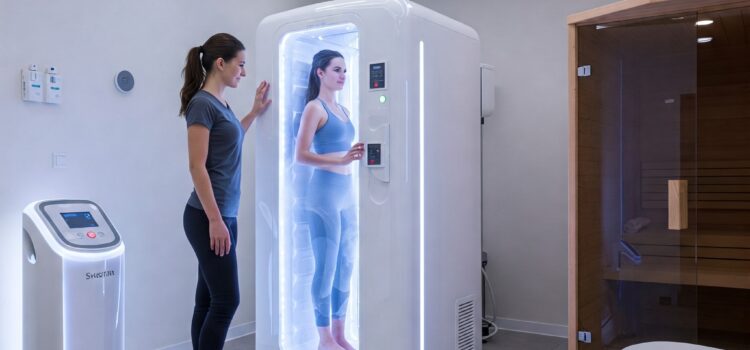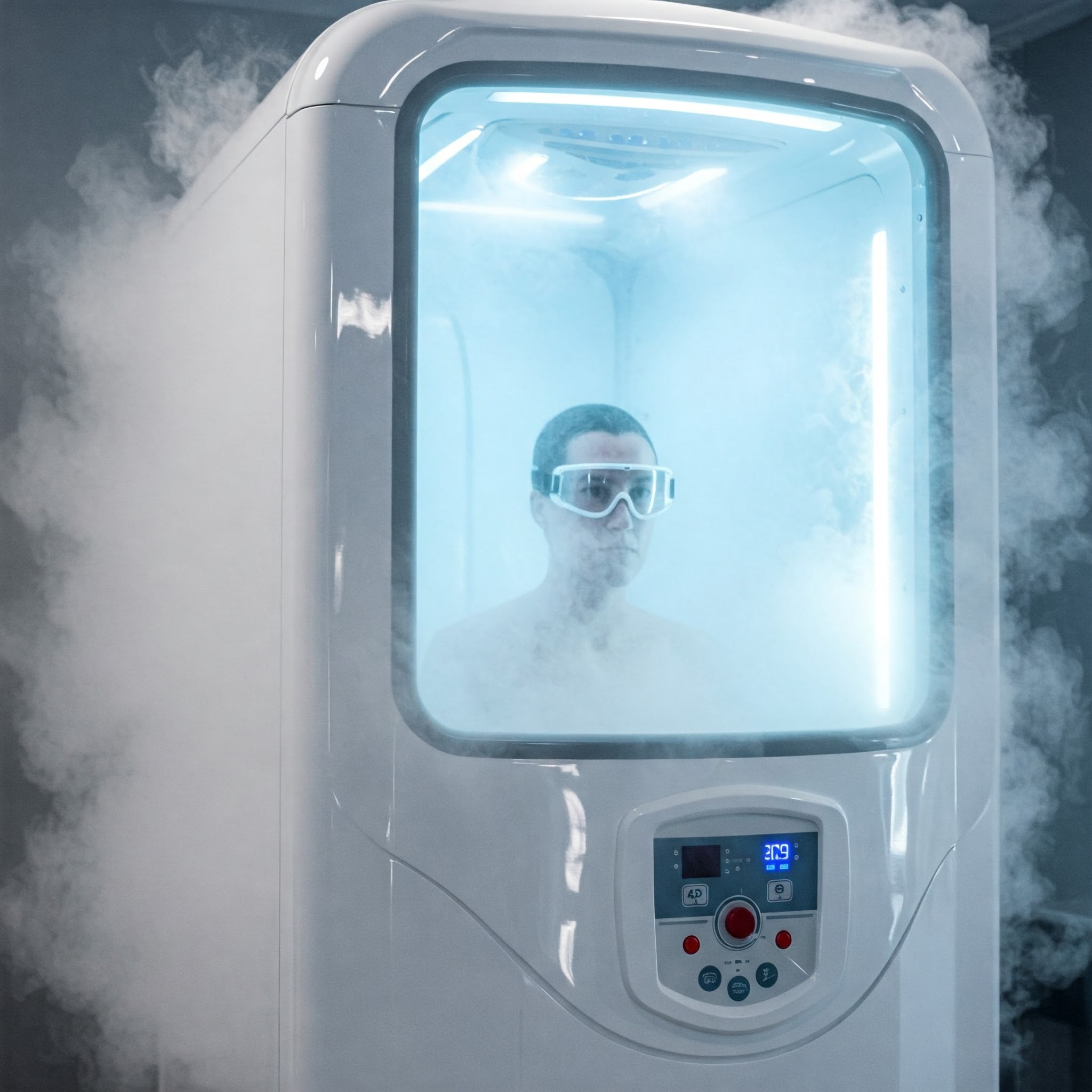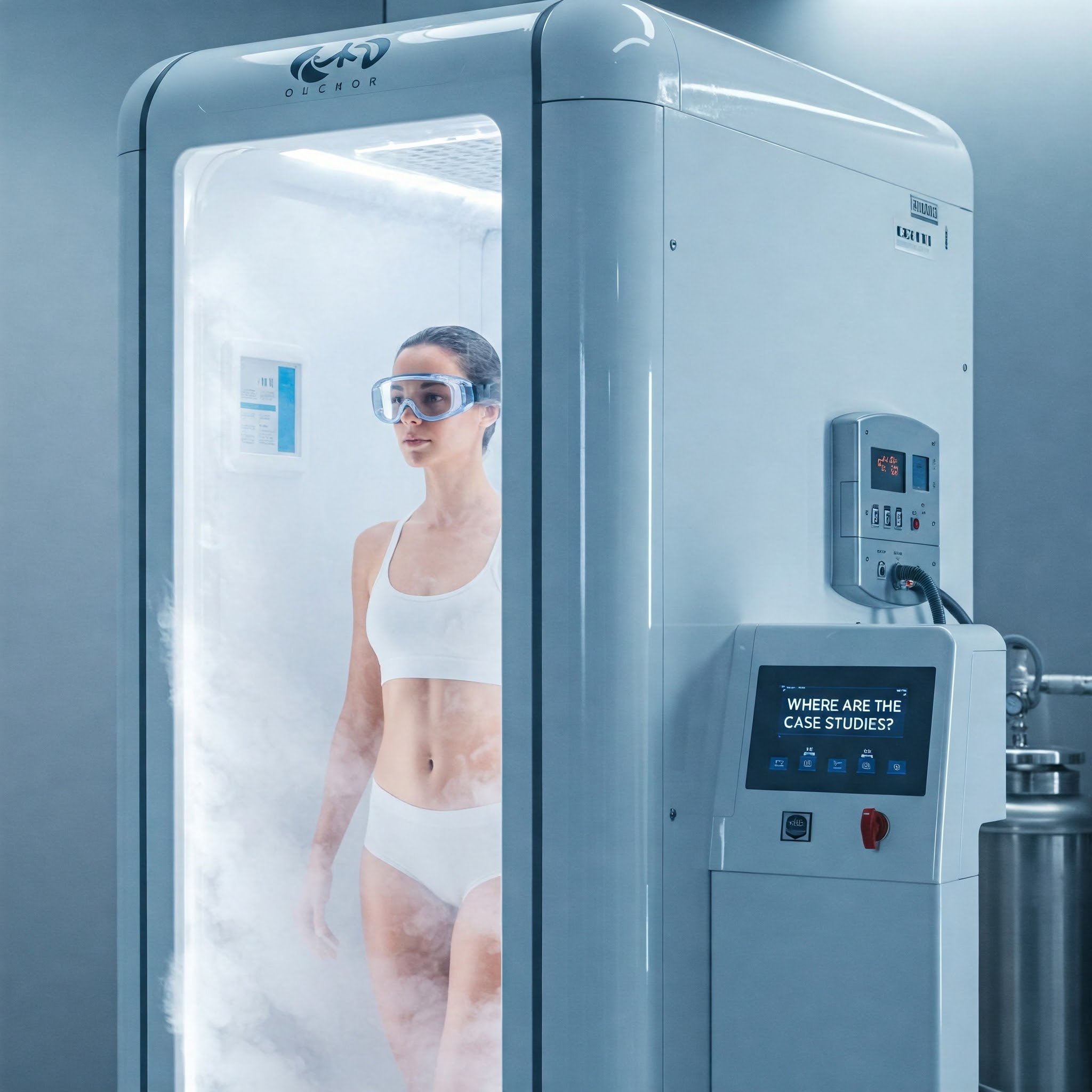Electric Cryotherapy Machines: An Analysis of Effectiveness, Owner Challenges, and Financial Implications
Cryotherapy, the therapeutic application of low temperatures, has been employed for centuries to address various health concerns. Modern advancements in this field have led to the increasing popularity of electric cryotherapy machines as a contemporary method for managing muscle pain and accelerating recovery. These devices offer a potentially safer and more convenient alternative to traditional cold therapy approaches such as ice packs or immersion in ice baths. Electric cryotherapy chambers are designed to provide precise temperature control and typically require shorter treatment durations compared to these established techniques. This research paper aims to provide a comprehensive analysis of electric cryotherapy machines, focusing on several critical aspects.
These include a detailed examination of the limited robust case studies provided by manufacturers to substantiate their effectiveness, an exploration of the challenges and areas needing improvement from the perspective of owners, and an in-depth analysis of the financial constraints associated with the maintenance, installation, and de-installation of these sophisticated devices. This investigation seeks to offer an objective and thorough understanding for individuals and businesses considering the adoption or current ownership of electric cryotherapy technology.
Defining and Understanding Electric Cryotherapy Machines
Electric cryotherapy machines are fundamentally enclosed, walk-in rooms engineered to utilize electricity for cooling the internal air to extremely low temperatures, typically ranging from -80°C to -110°C (-112°F to -166°F). These exposures are brief, usually lasting between two to three minutes, and are intended to trigger specific physiological responses within the human body. The core of these machines lies in their refrigeration-based cooling system. This system operates on principles similar to those found in common refrigerators, employing compressors and refrigerants to circulate and cool the air within the chamber. The refrigerant absorbs heat from the inside of the chamber and releases it outside, facilitating a rapid decrease in temperature.
Monitoring Temperature for Optimal Therapeutic Effect
Understanding the mechanisms of heat transfer is crucial to appreciating how electric cryotherapy affects the body. Heat transfer occurs through three primary means: conduction, convection, and radiation. Conduction involves the direct transfer of heat through physical contact, such as between the client’s skin and the cooled air. Convection is the transfer of heat through the movement of fluids or gases, in this case, the circulation of cold air within the chamber.
Radiation, while less significant in electric cryotherapy chambers compared to the other two, involves the transfer of heat through electromagnetic waves. Modern electric cryotherapy chambers are also equipped with an array of sensors that play a vital role in maintaining operational safety and efficacy. These sensors continuously monitor the temperature inside the chamber, ensuring it remains within the desired therapeutic range. Furthermore, safety features often include oxygen monitoring systems to prevent hypoxia and anti-freeze mechanisms to protect the skin from potential cold burns.
Key Categories of Electric Cryotherapy Machines
The market for electric cryotherapy machines encompasses several distinct types designed for various applications. Whole-body chambers are perhaps the most common type, designed to expose the entire body, including the head, to the ultra-low temperatures. These are frequently found in wellness centers, sports recovery facilities, and even private residences. Localized cryotherapy machines, also known as cryo facial machines or spot cryo devices, represent another category. These machines are designed to target specific areas of the body with a stream of cold air and are often utilized for localized pain relief in physiotherapy or for cosmetic procedures on the face and neck. A third type of electrically powered cold therapy device is the cryolipolysis machine, commonly known by the brand name CoolSculpting. These devices employ controlled cooling to target and reduce fat deposits in specific areas of the body and are predominantly used in the beauty and cosmetic treatment sector.
Diverse Applications of Electric Cryotherapy
The purported applications of electric cryotherapy machines are diverse, spanning across various fields. In sports recovery, they are promoted for their ability to reduce inflammation, alleviate muscle soreness, and combat fatigue following intense physical activity. Beyond athletic applications, electric cryotherapy is marketed for general wellness benefits, including pain management, elevation of mood, improvement in sleep quality, and a potential acceleration of metabolism. Furthermore, some proponents suggest potential therapeutic uses for managing symptoms associated with chronic conditions such as rheumatoid arthritis, fibromyalgia, and multiple sclerosis.
The fundamental difference between electric cryotherapy and nitrogen-based methods lies in the cooling agent. Electric systems utilize refrigeration technology, offering a potentially safer environment by eliminating the risks associated with nitrogen gas exposure. A significant advantage often highlighted by electric chamber manufacturers is the capability for full-body exposure, including the head, which some believe enhances the therapeutic effects by better stimulating the vagus nerve. While applications are broad, ranging from accelerated recovery for athletes to general wellness and potential therapeutic uses, the scientific evidence supporting all these claims varies considerably.
The Evidentiary Landscape: Examining Manufacturer Case Studies
An examination of the current scientific literature reveals a nuanced picture regarding the effectiveness of cryotherapy. For many of the benefits attributed to it, the evidence is often described as weak or inconclusive. While some studies suggest short-term relief from muscle soreness and faster recovery after exercise, the overall body of evidence supporting a wide range of claimed benefits remains limited. Notably, regulatory bodies like the Food and Drug Administration (FDA) have not approved whole-body cryotherapy for the treatment of any medical conditions, indicating a lack of sufficient scientific validation.
Investigating the availability and quality of clinical or case studies published by electric cryotherapy machine manufacturers presents a challenge. A review of the provided material indicates limited access to independent, rigorous clinical trials specifically focused on the effectiveness of electric machines. While manufacturers may feature case studies on their websites, the methodological quality and objectivity of such internally produced evidence warrant careful scrutiny. For instance, one snippet directs to a manufacturer’s page containing “Research & Case Studies”. However, it is important to recognize that case studies presented directly by the manufacturer may be subject to inherent biases due to commercial interests.
Evaluating the Evidence Behind Cryotherapy Claims
Marketing materials from electric cryotherapy machine manufacturers frequently emphasize the purported benefits and safety features of their products. These claims often include enhanced recovery from muscle injuries, improved athletic performance, better sleep patterns, and mood enhancement. Some manufacturers also highlight the safety of electric systems, citing the elimination of nitrogen gas risks and the inclusion of advanced monitoring and safety protocols.
However, it is crucial to evaluate these claims against the findings of independent research. The absence of numerous readily available, peer-reviewed studies specifically validating the effectiveness of electric cryotherapy machines for various conditions is a notable concern. This suggests a potential disconnect between the marketed benefits and the strength of the scientific evidence.
Recognizing Bias in Manufacturer-Supplied Data
There are inherent limitations and potential biases in data provided directly by manufacturers. Their commercial interest in selling their products may lead to an overstatement of benefits and a minimization of potential risks. Furthermore, case studies presented by manufacturers might suffer from methodological limitations such as the absence of control groups, small sample sizes, and reliance on subjective outcome measures, which can compromise their validity. Therefore, prospective buyers should exercise caution and critically evaluate all information provided by manufacturers, seeking out independent research findings to form a balanced and informed opinion.
Challenges and Areas for Improvement from an Owner’s Perspective
Owners of electric cryotherapy machines often report several common challenges. A significant hurdle is the high initial purchase cost associated with these devices, which tends to be greater than that of nitrogen-based systems. Additionally, the operation of electric cryotherapy machines can result in substantial electricity consumption, leading to potentially high utility bills. Maintenance poses another considerable challenge. These machines often require complex servicing that necessitates specialized technicians, frequently from the original manufacturer, which can be costly and lead to downtime. Reselling used electric cryotherapy machines can also be difficult due to their specialized nature and potential fragility. Finally, the installation of these chambers typically requires adequate space and may necessitate specialized electrical infrastructure, such as a 220V or higher power outlet, adding to the overall setup costs.
Several areas have been identified for improvement to enhance the owner’s experience. Streamlining the operation of electric cryotherapy machines through automation and more user-friendly interfaces could significantly improve ease of use. The development of clearer, evidence-based treatment protocols for various conditions would provide owners with valuable guidelines for optimizing the use of their machines. Ensuring the presence of robust and reliable safety mechanisms remains paramount for user well-being and minimizing liability. Owners also need greater assurance regarding the machine’s efficacy, which could be achieved through more transparent and credible data from independent research. Reducing the complexity and cost of maintenance is another critical area. This could involve the standardization of parts and an expansion of the network of qualified technicians capable of servicing these machines. Lastly, ensuring consistent temperature distribution throughout the treatment chamber is essential for maximizing the therapeutic benefits for clients.
Reducing Maintenance Costs and Complexity
To address these concerns, manufacturers could implement several solutions. Investing in rigorous, independent research to provide stronger evidence of the effectiveness of their machines for various applications is crucial. Developing more user-friendly and automated systems would improve the owner and client experience. Efforts should be made to enhance the reliability of the machines and reduce the overall cost of maintenance. Providing comprehensive training and ongoing support for owners and operators is also essential. Furthermore, manufacturers should consider the environmental impact of the refrigerants used in their systems and explore more sustainable alternatives.
The Financial Realities of Electric Cryotherapy Machine Ownership
The financial implications of owning an electric cryotherapy machine extend beyond the initial purchase price, encompassing significant ongoing and potential one-time expenses.
Maintenance Costs
The typical annual maintenance cost for a single-user electric cryotherapy chamber ranges from $1,000 to $3,000. However, for multi-user electric chambers, potential repairs can be significantly more expensive, ranging from $8,000 to $20,000. Replacement parts for electric cryotherapy machines are generally considered costly. Moreover, some manufacturers may mandate annual service checkups, which can incur costs between $3,000 and $5,000. Routine maintenance also involves regular tasks such as drying the chamber and cleaning any melt-off. While electric whole-body machines might have lower maintenance requirements compared to full-body electric or nitrogen-based machines, the cost of spare parts for electric systems can be higher. Several factors can influence the overall maintenance expenses, including the specific type of machine, the frequency of its use, its age, the geographical location, and the availability of qualified service providers.
Installation Costs
The costs associated with the initial installation of an electric cryotherapy machine can also be substantial. For single-user electric chambers, installation fees can range from $2,500 to $10,000. Multi-user electric chambers, due to their larger size and increased complexity, typically require a higher installation investment, around $15,000. Additionally, many electric cryotherapy machines require specialized electrical work, such as the installation of a 220V or even a 480V outlet, which adds to the overall cost. The final installation cost is influenced by factors such as the size and complexity of the machine, as well as the specific requirements of the facility where it is being installed.
De-installation and Relocation Costs
Information regarding the specific costs of de-installation for electric cryotherapy machines is not readily available in the provided snippets. However, it is reasonable to assume that the process would necessitate the engagement of professional technicians to safely and correctly disassemble the equipment. This would likely involve a service fee. If you need to relocate the machine, you’ll incur additional expenses for transportation and reassembly at the new location. The total cost for de-installation and relocation would depend on several factors, including the size and complexity of the machine and the distance of the move.
The financial commitment involved in owning an electric cryotherapy machine is considerable and encompasses not only the initial purchase but also significant ongoing maintenance expenses and upfront installation costs. Potential costs associated with de-installation and relocation should also be factored into the overall financial planning.
Table 1: Comparison of Electric Cryotherapy Machine Costs
| Machine Type | Average Initial Purchase Price | Estimated Annual Maintenance Cost | Estimated Installation Cost | Estimated De-installation/Relocation Cost | Key Considerations/Challenges |
|
Single-User Whole-Body |
$79,000 – $155,000 |
$1,000 – $3,000 |
$10,000 – $15,000 |
$10,000 – $15,000 |
Space requirements, electrical work required, complex repairs, expensive cooling agent, |
|
Multi-User Whole-Body |
$120,000- $300,000 |
$2,700 – $9,400 |
~$20,000 |
$15,000 – $20,000 |
Larger space needed, higher power consumption, complex repairs, outside condenser, expensive cooling agent |
|
Localized Cryotherapy |
$6,500 – $14,900 |
$300 – $1,000 |
$1,000 |
$500-$1000 |
Less space required, lower initial cost, shipping & crate |
Note: Costs are estimated based on the provided research snippets and may vary depending on the manufacturer, model, and specific circumstances.
Evaluate Manufacturer Claims Carefully
In conclusion, electric cryotherapy machines present a potentially safer alternative to nitrogen-based systems, offering the advantage of full-body exposure. However, a significant finding of this analysis is the lack of robust, independent clinical studies provided by manufacturers to definitively substantiate the numerous effectiveness claims made about these devices. Furthermore, owners of electric cryotherapy machines face considerable challenges, primarily related to the high initial investment, potentially high operational costs due to electricity consumption, and the complex and often expensive maintenance requirements.
You can improve the usability of the machines. You should also reduce maintenance costs and complexity. Provide stronger, more credible evidence of the benefits. Ownership costs go beyond the initial purchase price. You will face substantial annual maintenance expenses. Significant installation costs will apply, and relocation will incur additional expenses.
Conclusion and Future Directions
For prospective owners of electric cryotherapy machines, it is crucial to exercise thorough due diligence. This includes critically evaluating all claims made by manufacturers and actively seeking out independent clinical studies and reviews from current owners. Obtaining detailed quotes for the purchase, installation, ongoing maintenance, and potential de-installation or relocation of the machine is essential for accurate financial planning. Additionally, you should carefully consider the long-term financial implications, such as electricity consumption and mandatory annual maintenance.
Future research in this field could focus on several key areas. Researchers need to conduct independent, large-scale clinical trials to rigorously assess the effectiveness of electric cryotherapy for various applications. Comparative studies directly evaluating the efficacy of electric versus nitrogen-based cryotherapy systems would also be valuable. Additionally, researchers should focus on optimizing treatment protocols to maximize benefits and improving the energy efficiency of electric cryotherapy machines to reduce operational costs.
Works cited
Cryotherapy – Wikipedia, accessed April 22, 2025, https://en.wikipedia.org/wiki/Cryotherapy
Whole-Body Cryotherapy: Can Extreme Cold Improve Your Health? – WebMD, accessed April 22, 2025, https://www.webmd.com/pain-management/what-is-whole-body-cryotherapy
Cryotherapy for Athletes: How it works, Benefits | Mass General Brigham, accessed April 19, 2025, https://www.massgeneralbrigham.org/en/about/newsroom/articles/cryotherapy-for-athletes
en.wikipedia.org, accessed April 19, 2025, https://en.wikipedia.org/wiki/Cryotherapy#:~:text=Electric%20cryotherapy%20chambers%20are%20fully,response%20to%20the%20extreme%20cold.
pmc.ncbi.nlm.nih.gov, accessed April 16, 2025, https://pmc.ncbi.nlm.nih.gov/articles/PMC5411446/#:~:text=Recovery%20from%20injuries%20(e.g.%2C%20trauma,highlighting%20the%20underlying%20physiological%20responses.
Whole-Body Cryotherapy in Athletes: From Therapy to Stimulation. An Updated Review of the Literature, accessed April 16, 2025, https://pmc.ncbi.nlm.nih.gov/articles/PMC5411446/
Can Cryotherapy Help Athletes Recover Faster? – INTEGRIS Health, accessed April 16, 2025, https://integrishealth.org/resources/on-your-health/2020/august/can-cryotherapy-help-athletes-recover-faster
Whole-body cryotherapy: empirical evidence and theoretical perspectives – PubMed Central, accessed April 14, 2025, https://pmc.ncbi.nlm.nih.gov/articles/PMC3956737/



